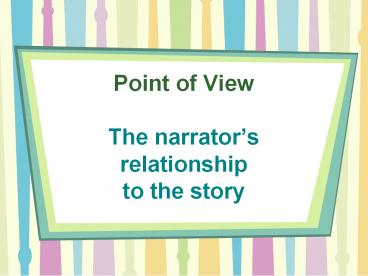Point of View The narrator - PowerPoint PPT Presentation
1 / 15
Title:
Point of View The narrator
Description:
Point of View The narrator s relationship to the story Why it is important An author s point of view choice influences how the story is revealed to the reader. – PowerPoint PPT presentation
Number of Views:109
Avg rating:3.0/5.0
Title: Point of View The narrator
1
Point of ViewThe narrators relationshipto
the story
2
Why it is important
- An authors point of view choice influences how
the story is revealed to the reader. - Point of view affects your responses to the
story. Your responses are influenced by how much
the narrator knows.
3
Why it is important
- Narrators are not always objective and
trustworthy. It is up to you to determine what is
the truth and what is not.
4
Narrator
- Think of a narrator as a guide, someone who takes
the reader from place to place, scene to scene,
pointing out objects of interest along the way.
The narrator may be a character in the story who
has a major impact on the readers or it could be
a trustworthy, reliable observer.
5
Objective
- With the objective point of view, the writer
tells what happens without participating in the
story's action and dialogue. The narrator never
discloses anything about what the characters
think or feel, remaining a detached, objective
observer.
6
Example
- Think of the objective POV as a camera recording
what is said and done during a specific period of
time. We cannot know what happens before or after
the camera is turned on and we cannot read
peoples mind while they are on camera. - Plays, drama
7
First Person
- Narrator is a character who does participate in
the action of the story - First person point of view uses "I" or "We.
Narrators recounting might not be the objective
truth. - Question the trustworthiness of the accounting.
8
Example
- I had a view of their kitchen and their
backyard, although I could not hear what they
said, I knew when they were arguing, when one of
them was sick, and many other things. I knew all
this by watching them at mealtimes.
9
Third Person Limited
- A non-participant narrator
- Narrator has omniscient (all knowing) knowledge
that is limited to one character (usually the
protagonist)
10
Third Person Limited
- Uses pronouns he or she
- The way people, places, and events appear to that
character is the way they appear to the reader
11
Example
- Marco felt like he had done something good for
the community. He felt like a helper and wanted
to do more good things to assist those in need.
But how did everybody else feel? How did Hannah
and Zach feel about their work? He would have to
talk to them to find out.
12
Third Person Omniscient
- A non-participant narrator who knows everything
about all the characters is all knowing, or
omniscient. - Refers to all characters with he or she
13
Third Person Omniscient
- The Narrator can move back forth from place to
place and time to time - Narrator knows thoughts and feelings of all
characters and may even reveal details the
characters themselves do not know
14
Example
- Marco felt like he had done something good for
the community. Hannah and Zach felt the same way,
too. Hannah had not been able to sleep. She was
excited at the thought of expanding their
project. She was sure they could provide even
more toys for the children next year! Zach was
already planning ways to raise more money and get
more people involved. He had even had a dream
about how to do it!
15
Steps to finding POV
- Check the pronouns
- Look for feelings
- Question past and future
- Count the characters the narrator knows about































